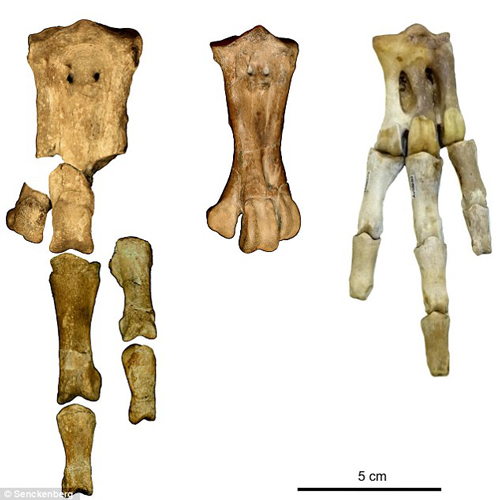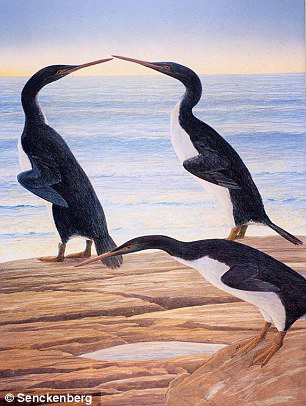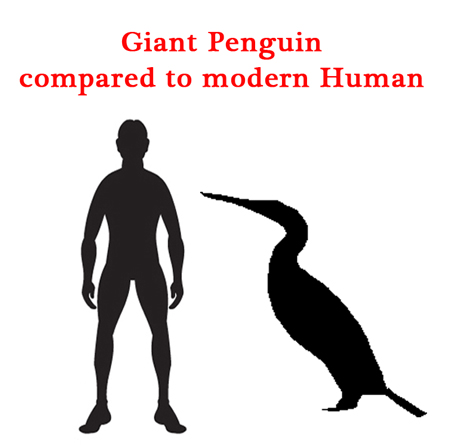Penguins Lived Alongside Dinosaurs (Probably) According to New Study
Giant Prehistoric Penguin 1.5 metres Tall
Ancient leg bones, found in Palaeocene-aged deposits located on the shoreline of Pegasus Bay near the city of Christchurch (New Zealand), has led scientists to propose that dinosaurs would have been familiar with penguins. Penguins and dinosaurs could have co-existed. In addition, the leg bone fossils indicate that after the dinosaurs died out, some penguins became super-sized, standing around 1.5 metres tall. The avian fossil material was excavated from sediments along the Waipara River, close to where this river meets the sea (Pegasus Bay). It has been estimated that this giant, primitive penguin lived in a coastal environment some 61 million years ago.
Penguins and Dinosaurs
Researchers from the Senckenberg Society for Natural Research (Frankfurt, Germany), have concluded that the penguin lineage is much older than previously thought, suggesting that these marine birds very probably evolved during the Late Cretaceous and the first kinds of penguins would have been very familiar to dinosaurs that wandered the remnants of the southern continent Gondwana.
A Super-sized Palaeocene Penguin

New specimen (left) compared to W. manneringi and an extant Emperor Penguin (Aptenodytes forsteri) on the right.
Picture credit: Senckenberg Society for Natural Research
The picture above compares the fossil leg bones of the newly discovered penguin species, with that of another, smaller Palaeocene penguin found in the same area Waimanu manneringi, which was formally described in 2006. The bones on the right are from the largest living species of penguin, the Emperor penguin (A. forsteri). This fossil supports the theory that the ancestors of modern Aves rapidly diversified after the end Cretaceous extinction event occupying a number of niches that had previously been occupied by other types of bird and theropod dinosaurs.
An Illustration of Waimanu manneringi
Picture credit: Senckenberg Society for Natural Research
When Did Penguins Evolve?
Although, Waimanu manneringi was a contemporary of the giant penguin, it had a different body plan, resembling a cormorant. The two types of penguin were very different, this suggests that basal penguins probably evolved prior to the end of the Cretaceous.
Co-author of the scientific paper, Dr Paul Scofield (Canterbury Museum, New Zealand), explained:
“We believed up until this specimen was discovered that there was very little variation amongst these Palaeocene penguins. We are now starting to understand that shortly after the extinction of the dinosaurs there were in fact two quite different groups of penguin.”
No Scientific Name as Yet
The lack of autapomorphies (distinctive features) and the fragmentary nature of the fossils has deterred the researchers from seeking to name their new prehistoric bird.
A spokesperson from Everything Dinosaur stated:
“The fossils probably represent a new species, however, with so few fossils to go on and with a lack of distinctive characteristics in the bones, it is not possible to erect a new species at the moment. Should more fossil material be found, especially skull material, then a new prehistoric bird species could come about.”
The Prehistoric Penguin Compared in Size with a Modern Human
Picture credit: Everything Dinosaur
For replicas and models of prehistoric animals: Eofauna Scientific Research Models.
The orientation of the leg bones suggests that, just like modern penguins, this ancient feathered friend probably waddled, walking in the same manner as its extant, smaller cousins. The fossil discovery is highly significant as it will likely be used as an “anchor point” to determine how the penguin family evolved. It is also very likely that other penguin species existed during the Palaeocene Epoch in this part of the world, but their fossilised remains have not yet been discovered.
Will More Fossils be Found?
The scientists are optimistic that the fossil site, just twenty miles north of the city of Christchurch, will yield further evidence of ancient sea birds. Although, around twenty-five percent bigger than the largest penguin species around today (Emperor penguin), these fossils do not represent the largest penguin known to science.
To read more about one of the largest known penguin species: Picking up a Giant Prehistoric Penguin.
Penguins were not the only creatures around today, that would have been familiar to the dinosaurs. Everything Dinosaur wrote an article after research had been published back in 2008 that suggested the bizarre duck-billed platypus co-existed with duck-billed dinosaurs.
To read the article: Duck-billed Platypus and the Duck-billed Dinosaurs.
Visit the Everything Dinosaur, user-friendly website: Everything Dinosaur.



